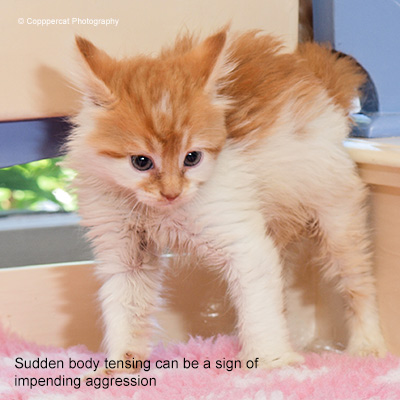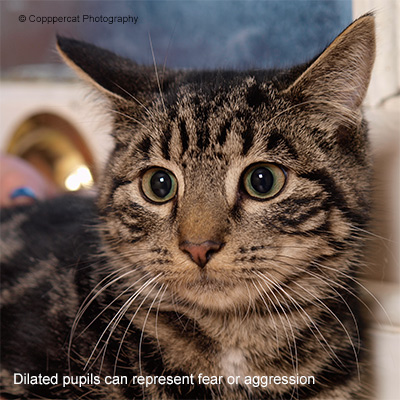There are many forms of aggressive behaviour that can be observed in cats. This page offers advice on the most common causes of cat aggression, and how to recognise and deal with it.
Aggressive Behaviour in Cats
If a cat plays too roughly, or suddenly lashes out, remember, it is not doing it out of spite! Cats aren’t aggressive just for the sake of being aggressive. First of all we need to consider what might be causing the aggressive behaviour, so we can work towards a solution.
It’s important though, not to confuse normal, active playing, with non-play aggression. Young cats and kittens in particular can appear to be quite rough in their play; chasing, pouncing, swatting and even biting each other. This is largely ’mock aggression’ and not intended to cause any harm. If this kind of play is directed at humans however, it can be misinterpreted as aggression, when in fact the cat merely wants to play.
There are many forms of aggressive behaviour observed in cats, such as playful, fearful and defensive, territorial, hierarchical (or social), petting, redirected aggression and idiopathic (cause not known). Below are some of the most common forms, and ways to deal with them:
Redirected Aggression
Redirected aggression usually occurs when a cat is aroused into an aggressive state by a person or animal, and takes the aggression out on those nearest. For example, if two cats have a dispute, then the losing cat may attack another nearby cat or human. Or perhaps when a cat returns from the vets, he may show aggression to the first person he sees, as he wasn't able to get to the vet who caused him pain or discomfort.
Redirected aggression can also be the result of stressful factors in the cat’s environment, for example strange threatening smells brought in from outside on shopping bags, clothing, shoes etc.
How you can Help:
Leave the cat alone when you know he's aroused! Whatever the reasons behind the cat's aggressive behaviour it is important that the cat is being provided with a calm and relaxed environment, and enough space.
Social Status or Hierarchical Aggression
Social status or hierarchical aggression can occur in a multi-cat household. Cats maintain social relationships when living in groups, and form a social structure - with a top cat and others in lower ranks. This may result in assertive displays such as; attacks or biting to gain attention, aggression during petting, attempts to control the environment by blocking doorways and refusing to be moved from sleeping areas, stalking family members or threats of aggression to humans passing by.
How you can Help:
In some cases it is enough to give the cats sufficient space, and places that they don't need to share with the others for sleeping, hiding etc. Not having to share amenities such as food, a litter tray, toys etc. can lessen the chances of conflict. When it looks like a fight is about to start, the cat carer can distract the cats with a loud or cat like sound, or by throwing a toy in the opposite direction, whilst leading one cat out of the room.
Rewarding non aggressive behaviour will help them to see that time spent with each other is a good experience. However, if two cats have been engaged in hierarchical aggression for a while then it might be better if they are re-introduced, by separating them, keeping the one with aggressive behaviour in another room with the essentials (e.g. food, water, litter tray, sleeping area, scratching post, toys, etc.) for a few days before the introduction process begins. (See our Feline Introductions and Hierarchies page for further information).
Petting & Playing Aggression

When kittens or young cats attack; biting hands and feet, or try to play but in a rough way, this can be associated with early weaning. A kitten that is separated from the mother too early may play more roughly than a kitten that has had more valuable family time to learn. In addition, if humans without realising play with a young kitten using their hands or feet instead of toys, they are giving the green light for rough play with people.
Another theory for petting aggression is that a cat may start out relaxed, enjoying being petted, but suddenly perceive that they are being handled by a larger, potential predator, and becoming disoriented they may attack, forgetting who is stroking them. This type of aggression indicates that there is a time limit to the cat’s patience in allowing a human to stroke and pet them.
How you can Help:
It is the human's task to teach the cat slowly to accept being stroked for longer, by reading the cat's body language. The carer can learn to stop petting the cat as soon as he shows signs of unease, and building up the cat's tolerance of being handled gradually. Twitching of the tail, backwards facing ears, dilated pupils, sudden tensing of the body are all indications that the cat is losing his patience. Gradually, the time of petting should be increased, as long as it is acceptable to the cat. Praising and rewarding your cat for non aggression will help, but remember; not all cats are lap cats or will ever become such, no matter how much we might try...!
To overcome rough play by the cat, the carer can offer alternatives for biting and wrestling, such as toys to redirect the cat's aggressive behaviour. A good way to start is to drag a favourite toy along the floor to encourage pouncing or chasing. A soft stuffed toy about the same size as the cat is ideal, so he can wrestle with it and kick it with his back feet. A good choice for this is the 'Wiggly Waggler' toy available from the Cat Chat Webshop.
Authoritative Power
There are cases where an aggressive cat appears to be 'in charge' in the house, bullying other cats and even humans. If the cat considers you as having a subordinate role, he won't respect you and can even turn on you if he feels threatened or challenged.
How you can Help:
The cat carer needs to behave like an 'alpha cat', who is actually in charge and not afraid, using some cat behaviour themselves. Growling (a universal vocalization) says "Watch out! I am angry". Hissing is another authorative sound - a cat knows well what a hiss means and will immediately back off. Cats are used to our human behaviour, so making these sounds will catch them by surprise. Using your size can help: If the cat is doing something wrong while you are sitting down, standing up and using a vocal sound will most definitely get the cat's attention.
Illness
In some cases the onset of aggressive behaviour could also be the result of some form of illness, or an indicator that the cat is in pain, especially if the behaviour starts very suddenly.
How you can Help:
If you are in any doubt as to why your cat is aggressive, seek veterinary advice.
Reducing Stress in Cats
Cats find routines and predictable environments comforting. Therefore playtimes, mealtimes, and bedtimes should occur at approximately the same time every day.
Ensure there are sufficient hiding places such as behind chairs, under beds, in cardboard boxes, or commercial cat-tunnels or tents. Access to high places such as cats trees, shelves and window sills will be welcome, as cats feel safer off the ground.
Sufficient playtime is important in using some of their energy. Play sessions should be about 10 to 15 minutes long, and at the same time of day. The location of playtime depends on the cat's personality. If he likes being the centre of things, play wherever the cat and his humans spend most of their time. If he is a timid cat then pick a quiet room.
Cats get bored with the same toys, so rotate cat toys weekly to maintain interest. ‘Hide & Seek’ is a fun game for cats, as 'found' toys are often more attractive to them. When playing, consider the cat's / kitten's own hunting habits, and choose toys that resemble mice or birds depending on preference. When playtime ends, put interactive toys away to keep the cat from getting bored with them.
Another way to stop, or even prevent aggressive behaviour is by using a Feliway Diffuser in different areas of your house to create a relaxed and calm environment. More information can be found at: www.feliway.co.uk. There is also a calming spray called 'Pet Remedy' which may help, and is available from most vets.
Stopping an Aggressive Outburst

Clapping can be a good distraction during an aggressive episode, but to avoid confusion, it will need to be associated with discipline only, and not used on other occasions.
Commands are most effective when a single word is used such as ‘stop’, ‘no’ or ‘off’. However, do not yell! Cats are highly sensitive to our different tones of voice, and can tell a shout (which is slightly hysterical) from a command.
These forms of discipline or distraction must be immediate, and applied only when the bad behaviour is in progress. The cat carer then needs to ignore the cat, and not rush to apologize as this will only cause confusion.
Never use physical punishment! It will not discourage aggression, and will make your cat fearful of you.
Take care to clean cat bites and scratches, and seek medical attention if in any doubt.
Further Help Available
Cat-to-Cat introductions: See our Introductions & Feline Hierarchies page for more information.
Behavioural Advice: Visit our Pet Behaviour links section.
Find your Nearest Vet Surgery: findavet.rcvs.org.uk
Our grateful thanks to K. Zurbanu BSc (Hons) (Psych) BSY(PetPsy) MSc (PRM) for providing the information for this page, and to Coppercat Photography for the photos.



